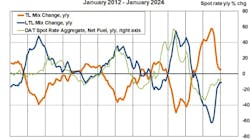The Environmental Protection Agency (EPA) and the National Highway Traffic Safety Administration (NHTSA) are extending the comment periods for the joint proposed rules “Greenhouse Gas Emissions and Fuel Efficiency Standards for Medium- and Heavy-Duty Engines and Vehicles - Phase 2,” and NHTSA’s Draft Environmental Impact Statement. The comment period for the proposed rules and the Environmental Impact Statement will now end on October 1.
The agencies have also placed new supporting material into the public dockets since the July 13 publication of the NPRM. For example: a new version of GEM (see “Files on DVD for EPA-HQ-OAR-2014-0827-DRAFT-0836 for GEM – Greenhouse Gas Emission Model Executable File”). The agencies also will be placing a description of potential changes to the GEM road grade profiles into the docket (see “Evaluation of Road Grade Profiles for Cruise Cycles with ISX/TC10 Powertrain”). The agencies welcome comments on these new materials along with other comments on the NPRM.
EPA and NHTSA says the “Phase 2 program” would significantly reduce carbon emissions and improve the fuel efficiency of heavy-duty vehicles, helping to address the challenges of global climate change and energy security.
Building on the first medium- and heavy-duty vehicle GHG emission and fuel efficiency standards (Phase 1), Phase 2 would further reduce fuel consumption and carbon pollution through performance-based standards based on robust technical data and extensive stakeholder outreach.
The agencies believe the new phase of the national program would benefit businesses and consumers, saving the industry billions of dollars’ worth of fuel, reducing the costs for transporting goods, while reducing GHG emissions by 1 billion metric tons; would spur innovation, encouraging the development and deployment of existing and advanced cost-effective technologies for a new generation of cleaner, more fuel-efficient commercial trucks; create opportunities for job growth; and provide an opportunity for U.S. industry to build on its position as a world leader in fuel-efficient trucking technologies.
Under these proposed standards, the fuel consumption of tractor trailers alone could drop as much as 24%.
For more information: http://www.epa.gov/otaq/climate/regs-heavy-duty.htm








